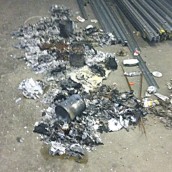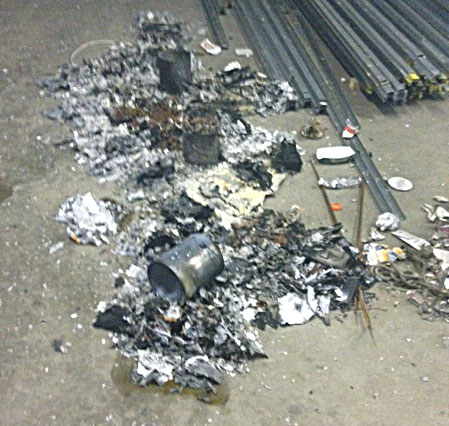Posted by Admin Account
Linseed Oil WARNING!


Over the years, DeckWise® has received calls from concerned customers notifying us they had a fire after using our Ipe Oil™ hardwood finish. What we have found is, that, these fires were caused by improper disposal and carelessness of rags used to apply the oil.
We are very aware of the potential for spontaneous combustion of rags, rollers, brushes, paper towels and even steel wool. We take great effort to make sure our labeling has the proper hazard warnings as well. However, we do realize some people do not take the time to read labels so we’re here for a refresher course.
Ipe Oil™ Label Warning
WARNING: Do not leave rags balled up, they will catch fire or self-combust. Rags, brushes, rollers, steel wool or waste soaked with Ipe Oil™ Hardwood Deck Finish may also spontaneously catch fire if improperly discarded. Immediately after each use, place waste materials in a sealed, water-filled metal container. Dispose of empty cans or unused portion in accordance with local, state, and federal regulations.
A culprit for these fires is an ingredient in many wood finishes called Linseed Oil. We’ve all used it before in some manner or fashion. Likewise, our Ipe Oil™ contains linseed oil, which many DIY people and contractors use to stain wood decking, furniture or fences each year. Linseed oil is a natural product extracted out of the flaxseed.
The unique properties of linseed oil is to soak into the grain of wood accentuating the grain giving it a perpetual “wet Look,” otherwise known as “popping the grain.” Since linseed oil naturally has a yellowish tint, we add a pinch of color to our Ipe Oil™ to improve the natural wood characteristics.
Liquid linseed oil in its container is no more hazardous than any other byproduct oil. The linseed oil by itself is not necessarily the problem. It’s the actual petroleum based solvents used to thin the linseed oil that is extremely combustible and flammable.
If a wood finish containing linseed oil is on a cotton rag for application, fire could spontaneously occur at as low as 120 degrees. That’s with no external spark. These thinning solvents in the linseed oil can generate heat through exothermic reactions with oxygen.
Rags and other application materials left in a pile, balled up or left unattended are a real problem. As air molecules combine with the linseed oil’s solvents, the resulting chemical reaction will accelerate the build up of heat. Since the linseed oil on rags becomes concentrated when in a pile or balled up, this in turn can spontaneously ignite the rag, which the linseed oil’s solvents then act as the fuel.
The reason we don’t see the finished wood with linseed oil catch fire, is because the linseed oil is spread out. There is no chance for heat to build up, hence, no fire.
Great care must always be taken when using and wood finish containing linseed oil. Always allow application materials to dry completely by laying them flat to dry on a non-flammable surface, out of the sun and heat. The best disposal method is to then place the dry rags in a canister of water and tightly seal the lid before you take it to your local hazardous waste site for disposal.
